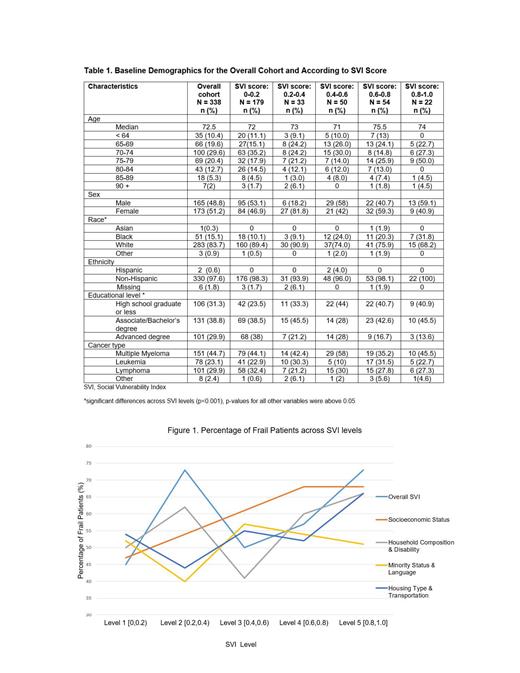Abstract
Introduction
Physically frail older adults with hematological malignancies experience greater treatment-related toxicity, higher rates of treatment non-completion, increased utilization of health care services, and shorter overall survival than younger and fitter patients. For frail adults, living in areas of high social vulnerability may also place them at disproportionately higher risk of experiencing poor health outcomes. Yet, the association between community-level social vulnerability and physical frailty among patients with hematological malignancies has not been previously described.
Methods
We used a previously developed frailty index [Carolina Frailty Index (CFI)] (Guerard et al., 2017) of accumulated health deficits, derived from geriatric assessment data of participants enrolled in the Carolina Senior Registry (CSR) (ClinicalTrials.gov identifier: NCT01137825) at the University of North Carolina at Chapel Hill or the Registry for Adults with Plasma Cell Disorders (ClinicalTrials.gov identifier: NCT03717844). In this cross-sectional study, we examined the association between county-level social vulnerability [Centers for Disease Control Social Vulnerability Index (CDC SVI)] (https://www.atsdr.cdc.gov/placeandhealth/svi/data_documentation_download.html. Accessed on July 1, 2021) and physical frailty in adults with hematological malignancies enrolled in the registries. In a cohort of 338 patients (CFI score range, 0-1), patients with a CFI score of 0.2 or above were considered frail. Social vulnerability was measured using participant residential zip codes and county locations linked to the overall SVI and each of the four domains: 1, socioeconomic status; 2, household composition & disability; 3, minority status & language, and 4, housing & transportation, that comprise the overall SVI (score range 0-1, with 1= most vulnerable). We used cut points of 0.2, 0.4, 0.6, and 0.8 to stratify the level of social vulnerability. Associations were made using Jonkherre-Terpstra tests for trends. All analyses were performed using SAS version 9.4 (SAS Institute, Inc). All tests were 2-sided, and p < 0.05 was considered statistically significant.
Results
Among 338 patients [51% male, 70% aged ≥ 70 years (median age 72.5 years) 84% White], multiple myeloma was the most common cancer type (45%), followed by lymphoma (30%) and leukemia (23%). Overall, 52% (n=177) of patients were considered frail. Just over half of the sample (53%, 179/338) lived in a county with an SVI <0.2, indicating the least social vulnerability. Only 6.5% (22/338) of the patients lived in counties with the highest social vulnerability (SVI score 0.8 to 1.0). Baseline demographics for the overall cohort and according to SVI levels are summarized in Table 1. Significant differences in race and education were seen across SVI levels (both p<0.001). In general, the proportion of patients categorized as frail increased with increasing levels of social vulnerability. These trends for overall SVI (p=0.01), the socioeconomic status (SES) (p=0.005), and the housing & transportation (p=0.048) domains (Figure 1) were statistically significant. As an example, for the overall SVI, the frailty rate was 73% (16/22) for patients residing in the most vulnerable counties (SVI score 0.8 to 1.0) compared to 45% (81/179) for patients residing in counties with the least social vulnerability (SVI score < 0.2). Similar differences were observed for SES (68% vs 47%) and housing & transportation (66% vs 54%).
Conclusion
Among older adults with hematological malignancies, those residing in areas of high social vulnerability were more likely to be physically frail. These findings suggest that external, contextual factors significantly influence an individual's overall health and highlight the need for further work in this area. Future research should examine community social vulnerability as a risk factor for physical frailty development in adults; information could then be leveraged to identify those at greatest risk for functional losses and frailty onset. Through early identification of this subset of patients, preventative strategies and interventions could be developed, and resources allocated to help those considered most vulnerable.
Rubinstein: Sanofi: Consultancy; Roche: Consultancy. Wildes: Sanofi: Consultancy; Seattle Genetics: Consultancy; Carevive: Consultancy; Janssen: Consultancy. Tuchman: Caelum: Consultancy, Research Funding; Sanofi / Genzyme: Consultancy, Research Funding; Shattuck Labs: Consultancy; Karyopharm: Research Funding; Oncopeptides: Consultancy.


This feature is available to Subscribers Only
Sign In or Create an Account Close Modal